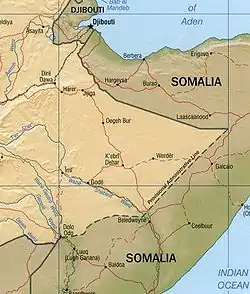1964 Ethiopian–Somali Border War
The 1964 Ethiopian–Somali Border War was a short war between the Somali Republic and the Ethiopian Empire in which Ethiopia attacked several towns along the Somali-Ethiopian border in response to Somalia signing a military assistance pact with the Soviet Union, which undertook to equip a 20,000-man army.
| 1964 Ethiopian–Somali Border War | |||||||
|---|---|---|---|---|---|---|---|
| |||||||
| Belligerents | |||||||
|
|
| ||||||
| Commanders and leaders | |||||||
|
|
| ||||||
| Strength | |||||||
|
Three Division~24000 34 M24 Tanks 39 M75 armoured personnel carriers. |
6000 army 5 Comet_(tank) | ||||||
Background

After the independence and unification of British Somaliland and the Trust Territory of Somaliland on July 1, 1960, one of the major goals of the Somali Republic was the unification of Greater Somalia, which included the Ogaden region in Ethiopia. The Somali government supported the Bale revolt led by Waqo Gutu that began in 1962.[1] On 16 June 1963, after the Ethiopian government attempted to collect taxes, Somali guerrillas started a minor insurgency at Hodayo, a watering place north of Werder. The guerrillas were greatly supported by the Somali government and operated in lowland Hararghe and Bale provinces. Their numbers eventually grew to about 3,000, but they never posed a serious threat to the government.[2]
The Mogadishu government became independent on July 1, 1960. Its flag was dominated by a star, three points of which represented Djibouti, the Somali-inhabited northern region of Kenya, and the Ethiopian Ogaden. Together, these made up Somalia irredenta. In the Ogaden, young men organized themselves into clandestine fighting units, heeding Mogadishu’s constant radio broadcasts to prepare for a war of liberation.
In February 1963, the Ethiopian government sought to introduce a head tax to help sustain development efforts in the Ogaden. Somali nomads vigorously resisted the tax and rebelled, supported by the armed bands and then, in the fall of 1963, by Somalian troops.
In November Mogadishu signed a military assistance pact with the Soviet Union, which undertook to equip a 20,000-man army. Shocked, the Ethiopians attacked Somalian border posts and adjacent towns in January 1964 and, after hard fighting, forced a cease-fire. Subsequent negotiations, however, were unable to resolve the differences between Somalia’s goal of uniting all its compatriots and Ethiopia’s need to retain its national integrity—as it was doing in Eritrea.[3]
Course of the War
In early February 1964, the Ethiopian army attacked from the direction of Dolo, with most of its forces attacking from Togochale (northeast of Jijiga) by General Andom, Third division commander. The Ethiopian attack on Togochale,[4] consisted of airborne company, an infantry battalion, an artillery battery, and a mechanized platoon with M24 tanks and with support from the air force, which began punitive strikes across the southwestern frontier against Feerfeer (northeast of Beledweyne) and Galkacyo. Despite being outnumbered and out gunned the Somalis fought the much larger invading force to a stand still that opened the way for talks in Khartoum.
Aftermath
On 6 April 1964, Somalia and Ethiopia agreed to a cease-fire. At the end of the month, the two sides signed an accord in Khartoum, Sudan, agreeing to withdraw their troops from the border, cease hostile propaganda, and start peace negotiations.[5][6] The border war also led the Organisation of African Unity to pass the Cairo declaration in July 1964 that called on all member states to respect existing borders.[7] the Khartoum negotiations led to the end of the Somali insurrection in the Ogaden for a time,[3] but it would be restarted before Somalia's next attempt to annex the Ogaden with the Ogaden War in 1977.
References
Notes
- Waal, Alexander De (1991). Evil Days: Thirty Years of War and Famine in Ethiopia. Human Rights Watch. p. 67. ISBN 978-1-56432-038-4.
- Waal, Alexander De (1991). Evil Days: Thirty Years of War and Famine in Ethiopia. Human Rights Watch. p. 71. ISBN 978-1-56432-038-4.
- "Somalia irredenta". Encyclopædia Britannica.
- Ayele 2014, p. 22.
- "Somalia profile - Timeline". BBC Africa. 4 January 2018. Retrieved 14 May 2018.
- "Onwar". Archived from the original on 13 April 2018. Retrieved 4 January 2018.
- "RESOLUTIONS ADOPTED BY THE FIRST ORDINARY SESSION OF THE ASSEMBLY OF HEADS OF STATE AND GOVERNMENT HELD IN CAIRO, UAR, FROM 17 TO 21 JULY 1964" (PDF).
Bibliography
- Ayele, Fantahun (2014). The Ethiopian Army: From Victory to Collapse. Northwestern University Press.